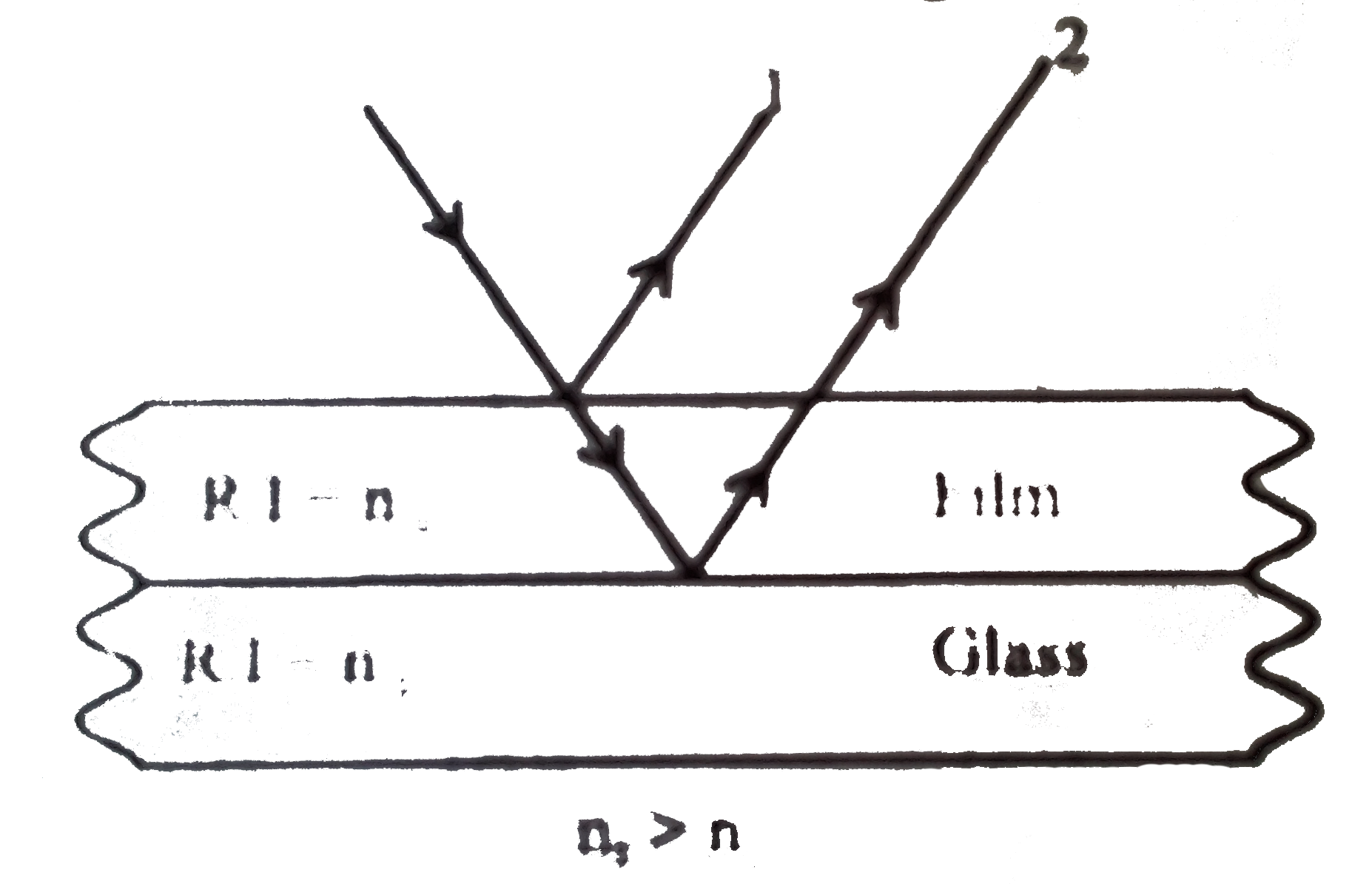A thin film of a specific meterial can be used to decrease the intensity of reflected light. There is destrucive inteference of wave reflected from upper and lower surface of the film. These films are called non-reflecting or anti-reflecting coatings. The process of coating the lens or surface with non-reflecting film is called blooming as shown in figure The refracting index of coating (n1) is less than that of the glass (n2).

6. If the thickness of film in above question in not technologically possible to manufacture, then next thickness of film required is (approximately)
A
298.9 nm .
B
271.7 nm
C
304.7 nm .
D
550 nm, .’
Video Solution
Text Solution
The correct Answer is:A
A
2n1t=3λ2
⇒t=3tminapro≅298.9nm
|
Updated on:21/07/2023
Related Playlists
- BOOK - FIITJEECHAPTER - OPTICSEXERCISE - Comprehension-3(prob)2videos
OPTICS
- BOOK - FIITJEECHAPTER - OPTICSEXERCISE - ASSERTION REASONING TYPE(prob)1videos
OPTICS
- BOOK - FIITJEECHAPTER - OPTICSEXERCISE - Comprehension-1(prob)3videos
OPTICS
- BOOK - FIITJEECHAPTER - MODERN PHYSICSEXERCISE - Numerical based questions5videos
MODERN PHYSICS
- BOOK - FIITJEECHAPTER - PHYSICS PART-IIIEXERCISE - NUMERICAL BASED QUESTIONS DECIMAL TYPE11videos
PHYSICS PART-III
Knowledge Check
- Question 1 - Select One
A thin film of a specific meterial can be used to decrease the intensity of reflected light. There is destrucive inteference of wave reflected from upper and lower surface of the film. These films are called non-reflecting or anti-reflecting coatings. The process of coating the lens or surface with non-reflecting film is called blooming as shown in figure The refracting index of coating (n1) is less than that of the glass (n2).

6. If the thickness of film in above question in not technologically possible to manufacture, then next thickness of film required is (approximately)A298.9 nm .B271.7 nmC304.7 nm .D550 nm, .’ - Question 1 - Select One
A thin film of specific material can be used to decrease the intensity of reflected light.There is destructive interference fo waves from uppe rand lower surface of the fil,m.These films are called non-reflecting coatings.The process of coating the lens of or surface with non-reflectig film is called bloomingas shown in fig.

Choose the correct statementsABoth 1 and 2 suffer change of π upon relfectionBOnlu 1 suffers a phase change of π upon reflectionCOnly2suffers a phase chagne of π upon reflection.DNeither 1 and2 suffer a phase change upon reflection. - Question 1 - Select One
A thin film of a specific meterial can be used to decrease the intensity of reflected light. There is destrucive inteference of wave reflected from upper and lower surface of the film. These films are called non-reflecting or anti-reflecting coatings. The process of coating the lens or surface with non-reflecting film is called blooming as shown in figure The refracting index of coating (n1) is less than that of the glass (n2).

5. magnesium fluoride (MgF2) is generally use as anti-reflection coating. If refractive index of MgF2 is 1.25, then minimum thickness of film required is (Take λ=500nm)A125 nmB75 nmC10 nmD225 nm - Question 1 - Select One
A thin film of a specific meterial can be used to decrease the intensity of reflected light. There is destrucive inteference of wave reflected from upper and lower surface of the film. These films are called non-reflecting or anti-reflecting coatings. The process of coating the lens or surface with non-reflecting film is called blooming as shown in figure The refracting index of coating (n1) is less than that of the glass (n2).

4. If a light of wavelength λ is incident normally and the thickness of film is t, then optical path difference between waves reflected from upper and lower surface of the film isA2n1tB2n1t−λ2C2n1t+λ2D2 t - Question 1 - Select One
A glass lens is coated on one side with a thin film of magnesium fluoride (MgF2)to reduce reflection from the lens surface (Fig. 2.26). The Index of refraction of MgF2 is 1.38, that of the glass is 1.50. What is the least coating thickness that eliminates (via interference) the reflections at the middle of the visible specturm (λ=550nm)? Assume that the light is approxmately perpendicular to the lens surface.
 A112.4nmB78.2 nmC99.64 nmD225 nm
A112.4nmB78.2 nmC99.64 nmD225 nm - Question 1 - Select One
A thin film of specific material can be used to decrease the intensity of reflected light.There is destructive interference fo waves from uppe rand lower surface of the fil,m.These films are called non-reflecting coatings.The process of coating the lens of or surface with non-reflectig film is called bloomingas shown in fig.

Magnesium fluoride(MgF2) is genertally used as anti-reflectioncoating.If refrative index of MgF2 is 1.35 then minimum thickness of film required is (Takeλ=550nm)A112.4mmB78.2mmC99.6mmDNone - Question 1 - Select One
When light is reflected from a surface it can be either regular reflection or diffuse reflection. The essential difference between regularly and diffusely reflecting surfaces is that
Aregularly reflecting surfaces are smoother than diffusely reflecting surfacesBlight can not be reflected from a diffusely reflecting surfaceCthe regularly reflecting surface is coarser than the diffusely reflecting surfaceDall of the above are essential differences between regularly and diffusely reflecting surfaces. - Question 1 - Select One
Statement -1: If an exceedingly thin soap film is seen in reflected light, it may appear dark
Statement -2 : Three is a phase difference of π from the rays reflected from front and rear faces of the film.AStatement-1 is true, statement-2 is true, statement-2 is a correct explanation for statement-2BStatement-1 is true, statement-2 is true, statement-2 is NOT a correct explanation for statement-1CStatement-1 is true, statement-2 is falseDStatement-1 is false, statement-2 is true - Question 1 - Select One
The angle of incidence at which reflected light is totally polarized for reflection from ait to glass (refractive index n), is :
Atan−1(n)Btan−1(1n)Csin−1(1n)Dsin−1(n) - Question 1 - Select One
The angle of incidence at which reflected light is totally polarised for reflection from air to glass (refractive index n) is
Asin−1(n)Bsin−1(1n)Ctan−1(1n)Dtan−1(n)

